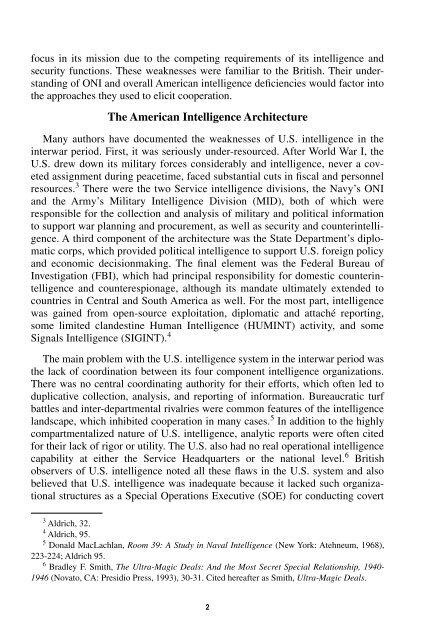Chapter 1THE STATUS OF INTELLIGENCE SYSTEMS IN THEUNITED STATES AND GREAT BRITAINSome of these difficulties stemmed directly from technical obstacleswhich limited the amount and type of intelligence that could beobtained....Those that were mainly organizational in character arose fromthe various pressures and resistances—administrative, psychological andpolitical—which complicate relations whenever several bodies shareresponsibility in a single field. They were all the more intractable, however,because developments in the field of intelligence were setting up conflictbetween the need for new organizational departures and theestablished, and perfectly understandable, distribution of intelligenceresponsibilities.Francis Hally Hinsley and others, British <strong>Intelligence</strong> in the SecondWorld War: Its Influence on Strategy and OperationsFrancis Hinsley’s comprehensive, official history of British <strong>Intelligence</strong> duringWorld War II describes the overall state of British intelligence on the eve of thewar. Hinsley’s comments about British intelligence could have equally beenapplied to its U.S. counterpart, which was also rife with bureaucratic rivalry andhad to cope with new organizational arrangements designed to handle newsources of intelligence. Understanding how each country approached intelligence,and how each managed the organizational structures they developed in theinterwar period to collect, analyze, and disseminate it, is fundamental to fathomingthe evolution of the intelligence relationship between the U.S. and the UK.Although many authors have denigrated U.S. intelligence capabilities during theinterwar years, recent scholarship has shown that, despite its many problems, theU.S. was probably not far behind the other major powers of the time. 2 Resourceconstraints, the ill-defined nature of the threat, and the lack of strategic directionall contributed to weaknesses in U.S. intelligence of the 1920s and 30s. TheNavy’s ONI suffered from other difficulties, as well, since it was beset withinternecine conflicts within the Navy Department over its role, and also lacked2Rhodri Jeffreys-Jones, “The Role of British <strong>Intelligence</strong> in the Mythologies Underpinning theOSS and Early CIA,” in American-British-Canadian <strong>Intelligence</strong> Relations 1939-2000, ed. DavidStafford and Rhodri Jeffreys-Jones (Portland, OR: Frank Cass Publishers, 2000), 5-10; Richard J.Aldrich, <strong>Intelligence</strong> and the War Against Japan: Britain, America, and the Politics of Secret Service(Cambridge: Cambridge <strong>University</strong> Press, 2000), 96-97.1
focus in its mission due to the competing requirements of its intelligence andsecurity functions. These weaknesses were familiar to the British. Their understandingof ONI and overall American intelligence deficiencies would factor intothe approaches they used to elicit cooperation.The American <strong>Intelligence</strong> ArchitectureMany authors have documented the weaknesses of U.S. intelligence in theinterwar period. First, it was seriously under-resourced. After World War I, theU.S. drew down its military forces considerably and intelligence, never a covetedassignment during peacetime, faced substantial cuts in fiscal and personnelresources. 3 There were the two Service intelligence divisions, the Navy’s ONIand the Army’s Military <strong>Intelligence</strong> Division (MID), both of which wereresponsible for the collection and analysis of military and political informationto support war planning and procurement, as well as security and counterintelligence.A third component of the architecture was the State Department’s diplomaticcorps, which provided political intelligence to support U.S. foreign policyand economic decisionmaking. The final element was the Federal Bureau ofInvestigation (FBI), which had principal responsibility for domestic counterintelligenceand counterespionage, although its mandate ultimately extended tocountries in Central and South America as well. For the most part, intelligencewas gained from open-source exploitation, diplomatic and attaché reporting,some limited clandestine Human <strong>Intelligence</strong> (HUMINT) activity, and someSignals <strong>Intelligence</strong> (SIGINT). 4The main problem with the U.S. intelligence system in the interwar period wasthe lack of coordination between its four component intelligence organizations.There was no central coordinating authority for their efforts, which often led toduplicative collection, analysis, and reporting of information. Bureaucratic turfbattles and inter-departmental rivalries were common features of the intelligencelandscape, which inhibited cooperation in many cases. 5 In addition to the highlycompartmentalized nature of U.S. intelligence, analytic reports were often citedfor their lack of rigor or utility. The U.S. also had no real operational intelligencecapability at either the Service Headquarters or the national level. 6 Britishobservers of U.S. intelligence noted all these flaws in the U.S. system and alsobelieved that U.S. intelligence was inadequate because it lacked such organizationalstructures as a Special Operations Executive (SOE) for conducting covert3Aldrich, 32.4 Aldrich, 95.5 Donald MacLachlan, Room 39: A Study in Naval <strong>Intelligence</strong> (New York: Atehneum, 1968),223-224; Aldrich 95.6Bradley F. Smith, The Ultra-Magic Deals: And the Most Secret Special Relationship, 1940-1946 (Novato, CA: Presidio Press, 1993), 30-31. Cited hereafter as Smith, Ultra-Magic Deals.2
- Page 1 and 2: COURTING A RELUCTANT ALLYAn Evaluat
- Page 4: The Joint Military Intelligence Col
- Page 8 and 9: FOREWORDTo most Americans alive tod
- Page 10 and 11: PROLOGUESince World War II, the Uni
- Page 14 and 15: action, a propaganda unit, or an ec
- Page 16 and 17: officers assisted by 20 civilian cl
- Page 18 and 19: ships in violation of treaty limits
- Page 20 and 21: assessments. By 1941, ONI was releg
- Page 22 and 23: might bear on their work.” 39 As
- Page 24 and 25: ility over time, its operational in
- Page 26 and 27: Chapter 2U.S.-UK RELATIONS, 1914-19
- Page 28 and 29: told by the Chief of Naval Operatio
- Page 30 and 31: ups of the early 20th century. 65 T
- Page 32 and 33: firmly believed that British polici
- Page 34: ecame one of the primary sources of
- Page 37 and 38: of shoring up their strategic weakn
- Page 39 and 40: mon framework for negotiation with
- Page 43 and 44: assuaged British concerns about the
- Page 45 and 46: In the area of intelligence exchang
- Page 47 and 48: clear to the Americans that if they
- Page 49 and 50: in his mind worked against closer c
- Page 51 and 52: praised the fighting spirit of the
- Page 53 and 54: through November of 1940 persuaded
- Page 55 and 56: and Great Britain. His principalcon
- Page 57 and 58: eceived by the British and from the
- Page 59 and 60: gear designed by the British. Altho
- Page 61 and 62: American Attitudes On Intelligence
- Page 63 and 64:
information did have an impact on K
- Page 65 and 66:
the affair. 183 This lack of resent
- Page 67 and 68:
tion exchanges. Even more significa
- Page 69 and 70:
nation (BSC) mission, is now availa
- Page 71 and 72:
good will and encouraged greater co
- Page 73 and 74:
would merely show Donovan “the be
- Page 75 and 76:
Lothian passed Hill’s proposal to
- Page 77 and 78:
still a powerful influence. While Z
- Page 79 and 80:
Since the Tizard Mission had only a
- Page 81 and 82:
appropriating large increases to th
- Page 83 and 84:
the French, a point which would not
- Page 85 and 86:
equested that RADM Ghormley remain
- Page 87 and 88:
when he [Pott] comes to O.N.I. he i
- Page 89 and 90:
it was not official U.S. policy. St
- Page 91 and 92:
efforts that had begun with the Sta
- Page 93 and 94:
high-level ABC-1 staff talks which
- Page 95 and 96:
to successfully interpret the instr
- Page 97 and 98:
to little more than a nebulous stat
- Page 99 and 100:
to offer.” 319 Others in the Brit
- Page 101 and 102:
Operational Intelligence Cooperatio
- Page 103 and 104:
Godfrey’s main concern was most l
- Page 105 and 106:
possesses complementary capabilitie
- Page 107 and 108:
2. Be prepared to give something of
- Page 109 and 110:
had in forming its own Joint Intell
- Page 112 and 113:
GLOSSARYABC-1ALUSNALondonBGENBSCCAP
- Page 114 and 115:
APPENDIX AA NOTE ON SOURCESArchival
- Page 116:
APPENDIX BMAJOR EVENTS IN U.S.-UK I
- Page 119 and 120:
________. Foreign Relations of the
- Page 121 and 122:
________. “The Secret of the Chur
- Page 123 and 124:
Zacharias, Ellis M., CAPT, USN. Sec
- Page 126 and 127:
INDEXAABC-1 Talks 41, 57, 74-75, 78
- Page 128 and 129:
IImagery Intelligence (IMINT) 12, 8
- Page 130 and 131:
Signals Intelligence(SIGINT) 2-3, 7
- Page 132:
PCN 53512ISBN 0-9656195-9-1
















